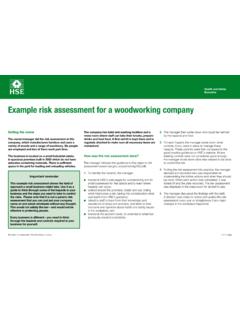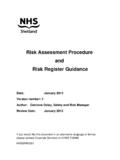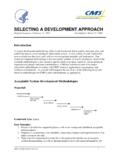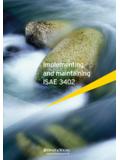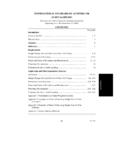Transcription of Basel Committee on Banking Supervision …
1 Basel Committee on Banking Supervision Consultative Document Simplified alternative to the standardised approach to market risk capital requirements Issued for comment by 27 September 2017 June 2017 This publication is available on the BIS website ( ). Bank for International Settlements 2017. All rights reserved. Brief excerpts may be reproduced or translated provided the source is stated. ISBN 978-92-9259-061-1 (online) Simplified alternative to the standardised approach to market risk capital requirements iii Contents Simplified alternative to standardised approach to market risk capital requirements.
2 1 Background .. 1 Next steps .. 2 Simplified alternative to the standardised approach to market risk capital requirements 1 Simplified alternative to the standardised approach to market risk capital requirements Background The standardised approach included in the standard Minimum capital requirements for market risk1 (hereafter revised market risk framework ) was developed to provide a risk-sensitive standard for banks that do not require a modelled treatment for market risk, to serve as a credible fall back to the internal models approach (IMA)
3 And to facilitate transparent, consistent and comparable reporting of market risk across banks and jurisdictions. The primary component of the standardised approach is the sensitivities-based method (SbM), which provides a framework that can be applied uniformly across a wide spectrum of banks in different jurisdictions while being sufficiently risk-sensitive with respect to the risks relevant to large, internationally active banks. As a standardised approach , however, the complexity of the SbM may pose implementation challenges for some banks (eg banks with a low concentration of trading book activity and smaller banks that typically do not have sufficient infrastructure for computing the SbM).
4 Moreover, in some jurisdictions, large banks face less complex risks . Broadly speaking, the current requirements of the SbM make the revised market risk framework s standardised approach difficult or not necessarily appropriate to implement and adopt across all Basel Committee on Banking Supervision member jurisdictions and non-member jurisdictions. For these reasons, and in order to make available a variant of the market risk framework that might be more suitable for implementation by supervisory authorities that wish to apply the Basel framework to banks other than large, internationally active banks, the Committee has developed a proposal for an alternative, simpler version of the SbM.
5 The reduced sensitivities-based method (R-SbM) is intended to address implementation challenges for banks that maintain smaller or simpler trading books. For banks that adopt the R-SbM, the standardised approach capital requirement will be the simple sum of three components: (i) the risk charges under the R-SbM (as proposed in this Consultative Document); (ii) the default risk charge (detailed in paragraphs 134-175 of the revised market risk framework); and (iii) the residual risk add-on (detailed in paragraph 58 of the revised market risk framework).
6 The proposed R-SbM makes a number of significant simplifications relative to the SbM, including the removal of capital requirements for vega and curvature risks , simplification of the basis risk calculation and a reduction in risk factor granularity and the correlation scenarios to be applied in associated calculations. While the use of the proposed R-SbM generally would be subject to supervisory approval and oversight, the proposed R-SbM should be applicable only to banks that meet certain qualitative and quantitative criteria, ensuring there is no cherry picking with respect to approaches for calculating market risk capital requirements.
7 National supervisors would have the authority to mandate that a bank apply the full SbM instead of the proposed R-SbM, even if the bank meets both the qualitative and quantitative criteria specified in the standard. 1 See Basel Committee on Banking Supervision , Minimum capital requirements for market risk, , January 2016. 2 Simplified alternative to the standardised approach to market risk capital requirements The Committee intends the proposed simplified alternative to the market risk standardised approach to further the goal of harmonisation of prudential standards across all jurisdictions and to mitigate the need for jurisdictions to make their own simplifications to the SbM or to retain the Basel II standardised approach as currently specified.
8 Nevertheless, the Committee acknowledges that the design of the R-SbM is significantly different from the design of the already widely-used Basel II standardised approach , and therefore could pose implementation challenges and costs that are disproportionate to the relative materiality of trading book risks for those banks for which this alternative has been proposed. In this regard, the Committee is also considering an alternative option of retaining a recalibrated version of the Basel II standardised approach . Although continued use of a version of the Basel II standardised approach by banks with less trading activity would represent a departure from the new, more risk sensitive market risk standard that will be used by large, internationally active banks, an upward recalibration of the Basel II standardised approach would serve to mitigate concerns over market risk capital requirement calibration that motivated the Committee s development of the revised market risk framework s standardised approach .
9 The Committee encourages commenters to provide views on whether the R-SbM as proposed represents a sufficient level of simplification to achieve the goal of harmonisation of prudential rules across all jurisdictions, or whether instead retaining the Basel II standardised approach , subject to a high-level recalibration to ensure a suitable conservativeness relative to that of the revised market risk framework, would serve as a better alternative. Subject to any further recommendations, the Committee intends the simplified alternative to the market risk standardised approach to be effective concurrent with the implementation date for the revised market risk framework.
10 Next steps The Committee welcomes comments from the public on all aspects of this consultative document by 27 September 2017. All comments will be published on the Bank for International Settlements website unless a respondent specifically requests confidential treatment. Once the Committee has reviewed responses, it intends to publish the final revised standard within an appropriate timeframe. Ahead of this publication, implementation arrangements (including the timetable) will be discussed by the Committee as appropriate, taking into account the target implementation of any finalised standard in tandem with the Pillar 1 implementation date for the broader revised market risk framework.











